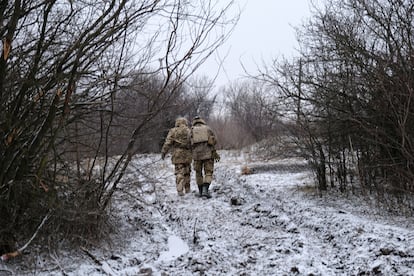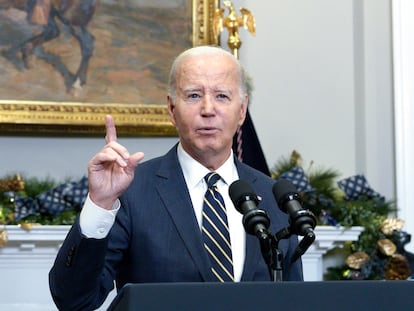Winter warfare in Ukraine – grounded drones and rat-infested trenches
Analysts and military officials say combat activity will decline due to the challenges of fighting in the cold

Ridley Scott’s Napoleon is a box office hit in Kyiv. Ukrainian audiences especially loved the scene where Moscow is engulfed in flames, sparking a flurry of posts on social media. The movie effectively depicts the grim reality of warfare in Eastern Europe, with healthy dashes of Hollywood-style drama. Whether in Austerlitz two centuries ago or in present-day Bakhmut, winter has always been an army’s greatest adversary.
Napoleon’s troops and Nazi Germany both faced defeat in the harsh Russian winter, sometimes personified as “General Winter.” The term gained popularity during the French invasion of the Tsarist Russia in the 19th century. While the cold has been Moscow’s greatest ally in past wars, the Russians now face a rival in Ukraine that is equally experienced in fighting in sub-zero temperatures.
The cold weather has led to a decline in the intensity of the fighting on both sides, according to the Institute for the Study of War (ISW), an American nonprofit research group and think tank. An ISW report released on December 1 found that weather conditions continue to slow the pace of combat operations conducted by Russia and Ukraine.
Thibault Fouillet of the Institute of Strategic Defense Studies at the University of Lyon (France), adds that there are other problems beyond the sub-zero temperatures. “We often only think about the cold and snow, but we shouldn’t overlook the impact of rain. It hampers mobility, particularly for armored vehicles, and causes flooding in the trenches. These factors contribute to [combat] inertia.” EL PAÍS consulted analysts like Fouillet and Ukrainian military officials to understand the main difficulties of fighting a war in the winter.
Grounded drones
The extensive use of drones is the primary military innovation in the war in Ukraine. During the intense Battle of Bakhmut last spring, up to 300 drones were deployed over the eastern Ukrainian city, including reconnaissance and bomb drones used by both armies, says Alexander, a commander in Ukraine’s 47th Brigade. Another 300 drones were deployed around Avdiivka (eastern Ukraine) in early autumn, but the cold weather has grounded many since then. Drone batteries have shorter lifespans in lower temperatures, and recent blizzards on the Donetsk front have also hampered drone flights. Low cloud cover also limits the use of reconnaissance drones.
In November, we reported from the Avdiivka frontline on the impacts of bad weather on drone operations. The day began with a dense fog, providing the Ukrainian artillery with an opportunity to unleash their fire upon the Russian positions. The Russian surveillance drones, including the high-altitude Orlan, struggled to pinpoint their targets. As the fog dissipated, Ukrainian artillery units stopped their assault and retreated. They were quickly replaced by Ukrainian pickup trucks mounted with anti-aircraft machine guns swarming over the battlefield.
Unusable vehicles
Snowy and icy roads can significantly impede the movement of cars and SUVs, which are crucial for transporting troops in both armies. When temperatures remain above freezing for extended periods, the combination of melted snow and rain turns roads into a morass of mud, preventing vehicles, including tracked and armored vehicles from advancing. Attack maneuvers are limited as slower convoy speeds increase their vulnerability to enemy artillery and drone attacks.
According to Ukraine’s commander-in-chief, Valerii Zaluzhnyi, the war in Ukraine will transition to a positional battle in the coming months. The two sides will engage in more infantry assaults but gain minimal ground. Alexandr Rose, a member of the Tor special forces group, says positional warfare is much less agile during winter. Camouflage becomes challenging when there are no leaves on the surrounding vegetation, and color changes are very noticeable in the all-white landscape. Rose explains that the temperature contrast between the body and the environment is more noticeable, making it easier for thermal optics to detect nighttime attacks during the long hours of winter darkness.
Mines buried under snow are harder to detect, said officers of the Ukraine’s 47th Mechanized Brigade. Infantry assault operations have to be cut short, due to the increased risk of frostbite and hypothermia, and soldiers wearing extra protective clothing are less agile.
Trench survival

In 1982, a military engineer named George K. Swinzow wrote a seminal essay about winter warfare for the United States Marine Corps. “Low morale is perhaps the most debilitating factor [of the cold],” wrote Swinzow. Life in the trenches becomes a wet, demoralizing torment of rampant disease in the winter. To prevent frostbite, soldiers are frequently rotated between watch duty and the warmer trenches. Digging new positions in winter is impossible in the frozen ground. Ukrainian and Russian soldiers have posted videos on social media showing underground shelters plagued by swarms of mice seeking warmth and food.
According to the Royal United Services Institute (RUSI), a British defense and security think tank, Ukraine should seize other opportunities during the harsh winter. Instead of attempting to break through defensive lines, Ukrainian troops can exploit vulnerabilities, forcing Russian forces to venture outside and face the elements. By strategically targeting Russian supply lines, Ukraine can maximize Russian casualties among poorly trained conscripts unaccustomed to winter warfare. Despite Russia’s superior firepower, says RUSI, it suffered significantly more casualties last winter.
Sign up for our weekly newsletter to get more English-language news coverage from EL PAÍS USA Edition
Tu suscripción se está usando en otro dispositivo
¿Quieres añadir otro usuario a tu suscripción?
Si continúas leyendo en este dispositivo, no se podrá leer en el otro.
FlechaTu suscripción se está usando en otro dispositivo y solo puedes acceder a EL PAÍS desde un dispositivo a la vez.
Si quieres compartir tu cuenta, cambia tu suscripción a la modalidad Premium, así podrás añadir otro usuario. Cada uno accederá con su propia cuenta de email, lo que os permitirá personalizar vuestra experiencia en EL PAÍS.
¿Tienes una suscripción de empresa? Accede aquí para contratar más cuentas.
En el caso de no saber quién está usando tu cuenta, te recomendamos cambiar tu contraseña aquí.
Si decides continuar compartiendo tu cuenta, este mensaje se mostrará en tu dispositivo y en el de la otra persona que está usando tu cuenta de forma indefinida, afectando a tu experiencia de lectura. Puedes consultar aquí los términos y condiciones de la suscripción digital.
More information
Últimas noticias
How Japan is trying to avert ‘digital defeat’
The complicated life of Francesca Albanese: A rising figure in Italy but barred from every bank by Trump’s sanctions
Half of Scotland is in the hands of 420 property owners
From digital curfews to blocking apps: How technology experts protect their children online
Most viewed
- Why we lost the habit of sleeping in two segments and how that changed our sense of time
- Pablo Escobar’s hippos: A serious environmental problem, 40 years on
- Trump’s obsession with putting his name on everything is unprecedented in the United States
- The Florida Keys tourist paradise is besieged by immigration agents: ‘We’ve never seen anything like this’
- Charles Dubouloz, mountaineering star, retires at 36 with a farewell tour inspired by Walter Bonatti










































